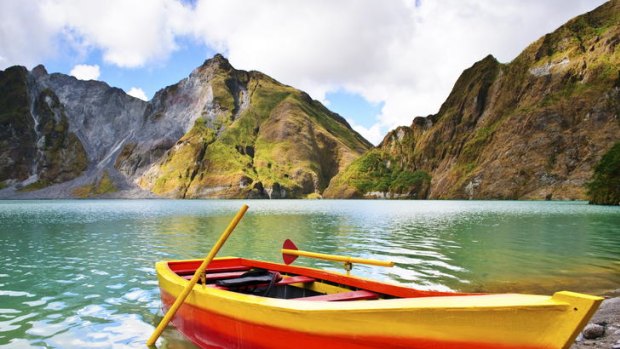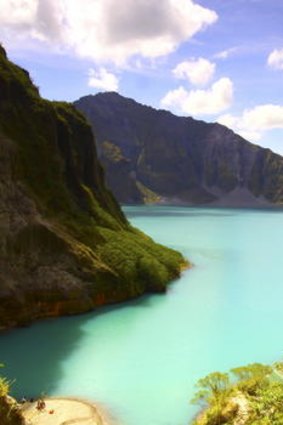
New ground ... a boat offers beach access.Credit: Getty Images
Where the top of Mount Pinatubo once was is a lake of immeasurable depth and beauty, writes David Whitley.
THIS was once farmland. Up ahead, it was once a banana plantation. Both have been smothered by the chalky grey overcoat of compacted ash. The desolate ground bears little trace of life. A rare green shoot attempts to make its way through. It will not have much company for a long time.
The 1991 eruption of Mount Pinatubo was one of the most devastating the world has seen. Ash clouds shrouded swathes of Asia, global temperatures dropped for three years afterwards and hundreds were killed. Surrounding villages were lost, the US air base at Clark was permanently put out of action - the Filipino government decided to kick the Americans out once it was usable again - and landscapes were dramatically altered.

Mount Pinatubo's crater lake.Credit: Getty Images
As the four-wheel-drive trucks judder their way from Pinatubo's trekking HQ, Santa Juliana, it is possible to see what the eruption did. Santa Juliana is 30 kilometres away from the crater and it is a suffocated valley, all the way. Pinatubo blew, a typhoon rolled in at the worst possible moment and the ash covering the area was turned into a mobile juggernaut.
Lahars, rivers of what may as well have been cement, poured down the valleys, gouging them, widening them and sweeping up hillsides.
The 4WDs stop where the valley turns into a gorge. From here, it is a two-hour trek to the crater. High, crumbling cliffs shepherd the way, the scars of avalanches worn all too clearly. Triangular dust piles have formed at the bottom; puffs of powder burst from the mountainsides as rocks come loose and tumble earthward.
The trek is a surprisingly unstrenuous one, suited to plodding carthorse types rather than nimble rock monkeys. The ascent is almost imperceptibly gradual, though you may as well accept that you are going to get your shoes wet rather than continually trying to find the right stepping stones.
The river that once was attempts to trickle through. It is now a stream. its bed has been buried and any water that gets through has to find its way into the gaps.
But it is a precious sign of life in a barren zone where you do not hear birds sing or cicadas chirrup. And the further up you get, the more of these signs emerge. The trail slowly morphs from dusty to rocky and as it nears the climax, green is winning the war against grey. Regrowth is fragile, but the wild, tropical vegetation that once dominated the top of Pinatubo is beginning to reassert its authority.
The top of Pinatubo no longer exists. It was scattered across Asia in 1991. In its place is something so beautiful that it is almost impossible to comprehend. The last step to the crater rim unveils a lake framed by the jagged remnants of the peak. Signs advise against swimming in the lake, but no one is prepared to pay attention to them. From the shore, the water gets very deep, very quickly. Yet it is thoroughly invigorating. Oxygen bubbles rising from beneath, however, remind that the lake rests on top of a dragon with a fearsome temper.
Gently lolling into each other by the water's edge are a couple of wooden rowing boats and an enterprising boatman. He is the passport to the other side of the lake, which he says is 77 metres deep, although the "No Swimming" signs state the depth is undetermined. On the far beach, there are fumes. Real fumes, not the wind blowing the ash. He will not take anyone to them - that is where real danger lies.
However, he will take passengers to a nearby beach. Here the water is warm. Small pools bubble; inquisitive hands are advised to stay well away. Digging a toe into the sand is a cue for anguished yelping. The scene looks like one of cherub-sculpted tranquillity, but it is a dazzling illusion.
The wind gets up on the way down. It becomes apparent why the guides wrap bandanas around their mouths. The ash floats across the gorge like a gently blown dandelion, and the fragility of this lahar-carved world becomes apparent. Some of the cliffs, those pointing upwards like termite mounds, look two-dimensional. They are like theatre sets with nothing behind them for support, liable to fall at any moment.
It becomes clear - the trek is passing through a landscape that is temporary and tumbling apart. The miniature explosions of ash pockets coming loose add a sense of restless drama. Twenty-one years ago, this valley looked nothing like it does now. In 21 years' time, it will probably look very different again.
Trip notes
Getting there
With Air Asia X (airasia.com) launching Sydney to Kuala Lumpur flights in April, there will be a one-stop option for flights to Clark Airport (Air Asia does KL to Clark legs). Brave the finicky leg-by-leg booking system and returns are available for less than $550.
Staying there
Sadly, many of the hotels near Clark are of the red-light variety. The Angeles Beach Club Hotel offers a less seedy option from 4900 pesos ($107) a night. +63 45 892 2222, angelesbeachclubhotel.com.
Touring there
It is best to overnight in Clark or Angeles City before doing the trek. It can be done as a day trip from Manila but it will require a very early start. Amega Travel (+63 45 892 5318, amegatravelandtours.com) organises tours with hotel pick-up, four-wheel-drive trip, guides and lunch from 2800 pesos, based on at least four in the group. The boat ride on the crater lake costs an extra 350 pesos a person.
More information
tourism.gov.ph.
Sign up for the Traveller Deals newsletter
Get exclusive travel deals delivered straight to your inbox. Sign up now.